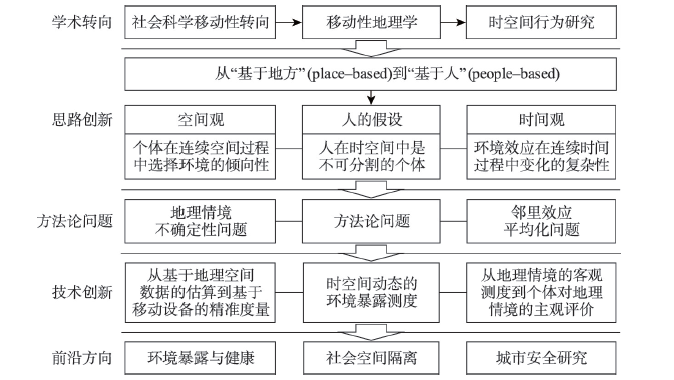

Advances in space-time behaviour studies: From the perspective of geographies of mobility
Received date: 2022-09-12
Revised date: 2023-03-03
Online published: 2023-04-14
Supported by
National Natural Science Foundation of China(42071203)
National Natural Science Foundation of China(41529101)
Against the backdrop of increasing mobility in human society, the approach of geographies of mobility have profoundly influenced various branches of the geography discipline. In this article, we review how geographies of mobility have developed traditional space-time behaviour studies. First, by shifting from a place-based to a people-based perspective, geographies of mobility seek to understand the interaction between indivisible individuals and continuous space-time, thereby addressing the uncertain geographic context problem and neighbourhood effect averaging problem. Second, new methods have been developed for capturing individuals' complex mobilities and dynamic environmental exposures. These range from estimation based on geographical data to real-time measures based on mobile devices as well as subjective measures of environmental exposure and people's perception of geographical contexts. Third, empirically, the geographies of mobility have made methodological contributions to three space-time behaviour research agendas, namely, health geography, social segregation, and urban safety. In short, rising mobility in contemporary urban China poses challenges to traditional methodologies in space-time behaviour studies while also providing opportunities for methodological innovation in this research field. The school of Chinese behavioral geography should keep pace with research on mobility and should keep the geographies of mobility in mind when advancing methodologies and empirical studies.

XU Weilin , CHAI Yanwei . Advances in space-time behaviour studies: From the perspective of geographies of mobility[J]. Acta Geographica Sinica, 2023 , 78(4) : 1015 -1027 . DOI: 10.11821/dlxb202304015
表1 时空间行为研究的传统范式与移动性地理学范式对比Tab. 1 Differences between the traditional approach and mobility geography approach to the research into human's space-time behaviour |
| 传统的研究范式 | 移动性地理学的研究范式 | |
|---|---|---|
| 出发点 | “基于地方”(place-based),先入为主地假设特定地方的环境是影响个体行为的主要因素 | “基于人”(people-based),强调追踪个体在时空间中的移动性以及“真实”的环境暴露 |
| 空间观 | 活动空间被分门别类,当前环境暴露与后续环境选择的关系难以被完全捕捉到 | 假定人有环境选择的能力和倾向,观察个体移动的连续空间过程后,判断行为与空间关系的整体性 |
| 时间观 | 时间被分割成为片段,假定环境暴露效应起止于活动时间段内 | 考察个体移动的不间断时间过程,研究环境效应随时间变化的复杂性特征 |
感谢香港中文大学关美宝老师对北京大学时空间行为研究团队的长期支持,使我们得以较为全面地学习并应用了其思想与方法;同时感谢审稿专家给予的建设性意见。
| [1] |
|
| [2] |
|
| [3] |
|
| [4] |
|
| [5] |
|
| [6] |
|
| [7] |
|
| [8] |
[朱璇, 解佳, 江泓源. 移动性抑或流动性? 翻译、沿革和解析. 旅游学刊, 2017, 32(10): 104-114.]
|
| [9] |
|
| [10] |
|
| [11] |
[朱璇. 移动地理研究的一种理论框架: 基于文献分析. 人文地理, 2021, 36(6): 9-18, 156.]
|
| [12] |
|
| [13] |
|
| [14] |
|
| [15] |
|
| [16] |
[盛明洁. 欧美邻里效应研究进展及对我国的启示. 国际城市规划, 2017, 32(6): 42-48.]
|
| [17] |
|
| [18] |
|
| [19] |
|
| [20] |
|
| [21] |
|
| [22] |
|
| [23] |
|
| [24] |
|
| [25] |
|
| [26] |
|
| [27] |
|
| [28] |
|
| [29] |
[谭一洺, 柴彦威, 关美宝. 地理背景的不确定性对时空行为模式分析的影响: 基于西宁市的实证研究. 地理学报, 2017, 72(4): 657-670.]
|
| [30] |
|
| [31] |
|
| [32] |
|
| [33] |
|
| [34] |
|
| [35] |
|
| [36] |
|
| [37] |
|
| [38] |
|
| [39] |
|
| [40] |
|
| [41] |
|
| [42] |
|
| [43] |
|
| [44] |
|
| [45] |
|
| [46] |
|
| [47] |
|
| [48] |
|
| [49] |
|
| [50] |
|
| [51] |
|
| [52] |
|
| [53] |
|
| [54] |
|
| [55] |
|
| [56] |
|
| [57] |
[马昕琳, 柴彦威, 张艳. 郊区配建社区的居住混合与行为分异: 以北京美和园社区为例. 城市发展研究, 2020, 27(3): 55-62, 76.]
|
| [58] |
|
| [59] |
|
| [60] |
|
| [61] |
[柴彦威, 许伟麟, 张文佳, 等. 新冠肺炎疫情精准防控的时空间行为地理学研究框架. 地理科学, 2020, 40(10): 1585-1592.]
|
| [62] |
|
| [63] |
|
| [64] |
|
| [65] |
[柴彦威, 李春江. 城市生活圈规划: 从研究到实践. 城市规划, 2019, 43(5): 9-16.]
|
| [66] |
[杨婕, 柴彦威. 城市体检的理论思考与实践探索. 上海城市规划, 2022(1): 1-7.]
|
/
| 〈 |
|
〉 |